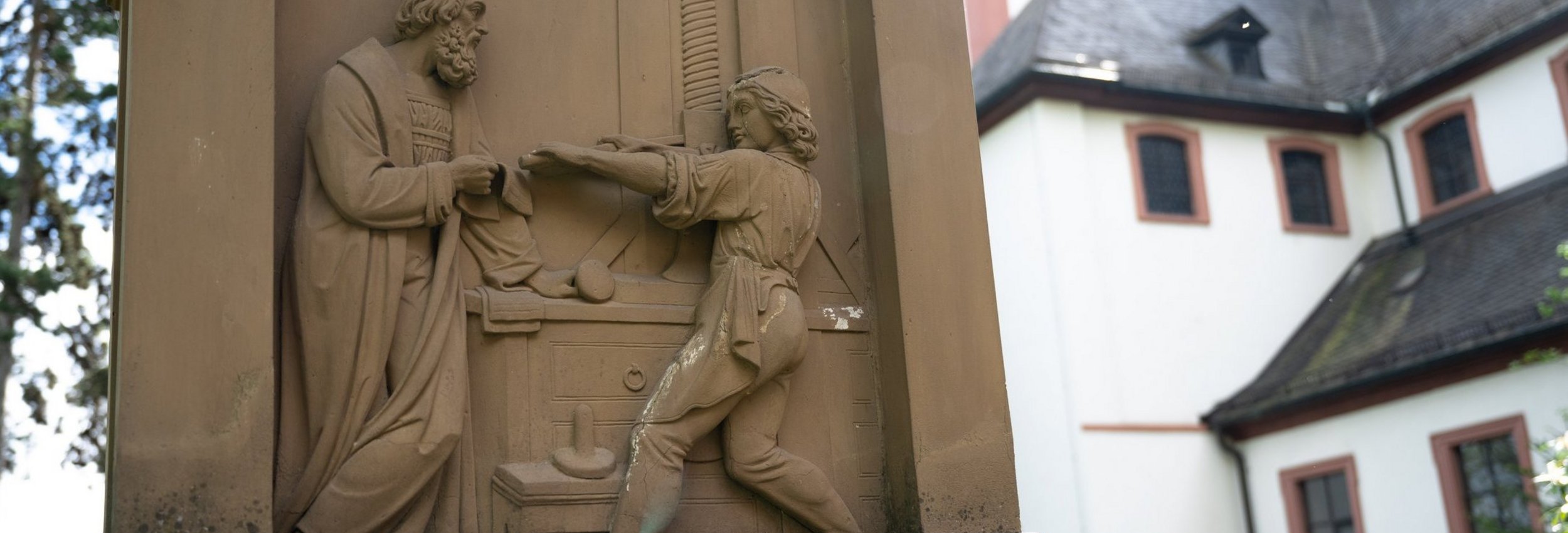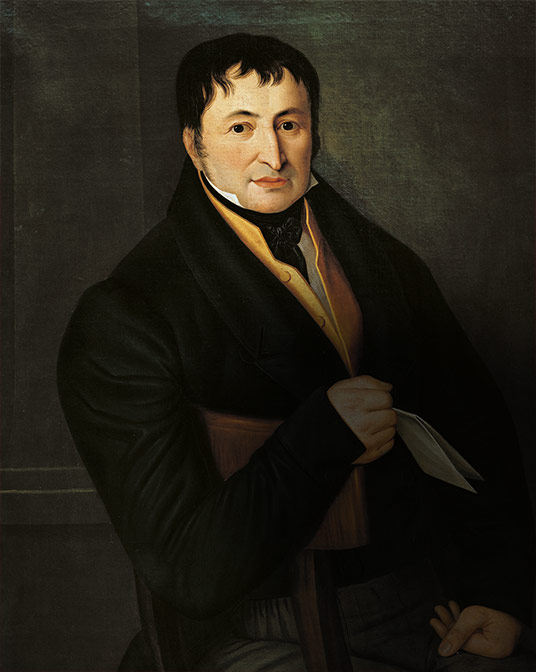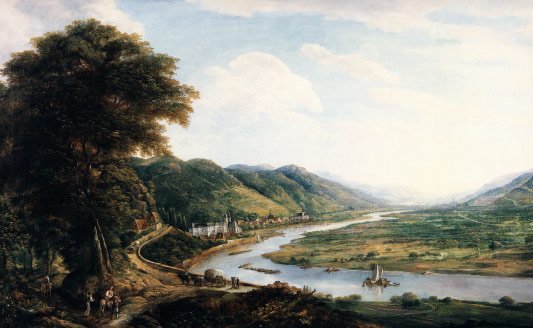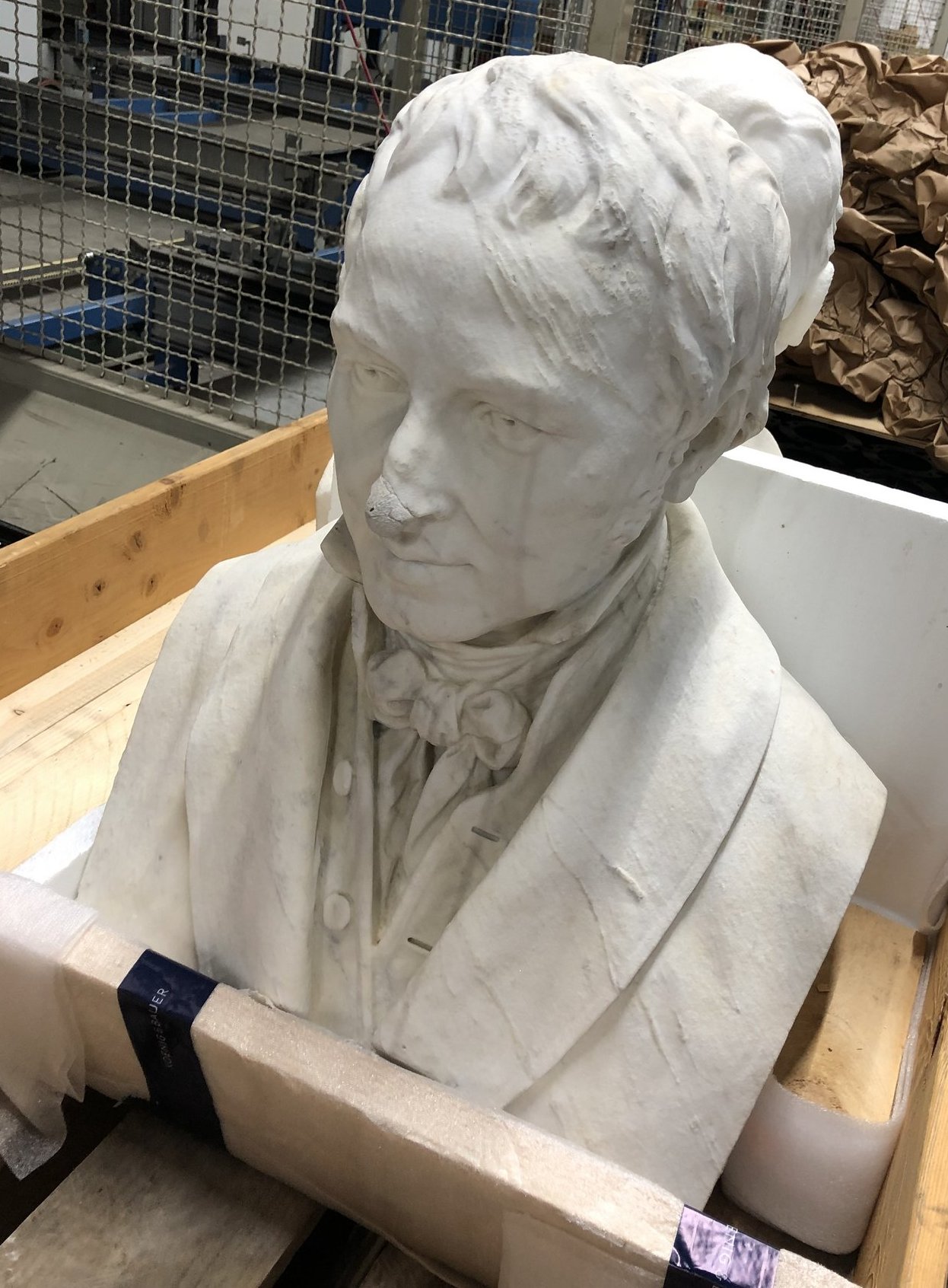
Public Recognition for the Inventor of Mechanised Printing
With his invention of a cylinder printing press, Friedrich Koenig transformed the world of print and wrote a landmark chapter of media history. His significance as a book printer, businessman and inventor remains undiminished even today. And he is still remembered in many of the places connected with his life and work – through memorials, streets and schools bearing his name, and mentions in leading museums. Join us on a tour to some of these places.
Eisleben – Koenig’s birthplace
Friedrich Koenig is probably the best-known person in the town’s history after Martin Luther. This makes it hardly surprising that he is remembered at several locations around the town.
He was born in house no. 48 on Lindenallee, a rather plain building compared to many others in the neighbourhood. A granite plaque above the entrance bears the bronze inscription “Born in this house on 17th April 1774, Friedrich Koenig / Inventor of the high-speed book-printing press”.
Even more than 130 years ago, the town had named a local street after Friedrich Koenig. Lined with imposing residential buildings on its south side, it runs along the former town moat, today a park between the villa district and the town centre. To mark the 80th anniversary of the patent granted to Koenig for his printing press, the town honoured its famous son by erecting a memorial in 1891 – a larger-than-life bronze bust on a polished granite pedestal with Baroque-style volute ornaments. It is enclosed by decorative wrought-iron railings. The memorial stands prominently above the town moat and is inscribed “TO THE / INVENTOR OF THE / PRINTING MACHINE / FRIEDRICH / KOENIG / A SON OF / EISLEBEN”. The bust is the work of Berlin sculptor Fritz Schapers. He was one of the most important representatives of his art in the late 19th century and is also responsible for the creation of the gable relief on the Reichstag in Berlin.
Thankfully, a cast was made when the original bronze bust of Friedrich Koenig was removed and melted down in 1942. This was used to produce the current cast-iron bust which has adorned the memorial pedestal since 1952. Another interesting fact: representatives of Koenig & Bauer attended the unveiling of the memorial. Friedrich von Koenig, the youngest son of the company founder, is said to have given a speech in which he thanked the town for the great honour accorded to his father.
Leipzig – centre of the graphic arts
Friedrich Koenig began a book-printing apprenticeship at the renowned printing company Breitkopf & Härtel in Leipzig in 1790. At that time, there was still no intimation that his inventions would one day revolutionise the whole industry. As a centuries-old centre of book printing and the graphic arts, however, it seems appropriate that Leipzig should also commemorate the famous inventor. Between 1898 and 1901, the German Book Trade Association commissioned an opulent neo-renaissance building with exhibition space for its annual innovation show, as well as for the German Book Trade Museum and a machine exhibition. The centrepiece was the 12-metre-high Gutenberg Hall, for the end wall of which Leipzig sculptor Adolf Lehnert produced a three-metre statue of Johannes Gutenberg. This statue was flanked by two portrait busts – one of Alois Senefelder, the inventor of lithography, the other of Friedrich Koenig, the inventor of the mechanised printing press.
A large part of the building fell victim to an air raid at the end of 1943. Following reconstruction, exhibitions resumed in 1951, including what was then the world’s largest special exhibition of the printing trade in 1954. The Gutenberg Hall, however, was lost for all time. The elaborately restored complex is now an elegant residential development.
A second monument in Leipzig pays direct tribute to Koenig & Bauer and can still be seen today: a branch of the company was set up at Grenzstraße 21 (today Ludwig-Erhard-Straße 21) around 1905. The three factory buildings with yellow and green brick facades were also used to repair printing presses after 1945 – initially still under the name Koenig & Bauer. They have since been renovated and now accommodate a mix of apartments, offices and small businesses.
The basket-handle arch of the passage through the front building of the three is framed by a sandstone portal with floral ornamentation. Medallions on the top depict the company founders Friedrich Koenig (right) and Andreas Bauer (left). It can be assumed that there was once an inscription in the now empty panel in the centre, probably the company name. The portal is protected as a listed monument and can be viewed on a tour of the city’s historical printing district.
Suhl – origin of Koenig’s wood-built press
The years spent in Suhl, a small town famous for its well-equipped technical workshops, were among the most significant in Friedrich Koenig’s life. It was here in the workshop of Wolfgang Kummer, starting in 1803, that he designed his first printing press, a wooden construction that took its name from the town. Parts of this press remained in storage in a building on Herrenstraße in Suhl for many decades, but were later lost in the course of demolition work. It is likely that Koenig was again a frequent visitor to Suhl after returning from England and establishing the first printing press factory in Oberzell in 1817: on the one hand to recruit employees for his factory, but also because his later wife Fanny Jacobs lived in the town.
In 1993, Suhl renamed one of its main thoroughfares Friedrich-König-Straße (taking the spelling he used before his stay in England) to commemorate his achievements as an inventor and company founder. A sign by the road gives a few facts about its name-giver. The state grammar school in Suhl has also borne the name Friedrich König since 2015. It was a joint decision of the pupils and teachers to name their school after the inventor of the ‘Suhl printing press’.
Oberzell and Würzburg – founding of a printing press factory
With the founding of Koenig & Bauer in 1817, Friedrich Koenig created what we can today consider the most important monument to himself. The factory in the former Oberzell monastery has since grown to become one of the leading printing press manufacturers in the world.
Visitors to the company are greeted to its headquarters on Friedrich-Koenig-Straße. And the extensive grounds will soon be adorned once more by two busts commemorating the company founders Friedrich Koenig and Andreas Bauer. They are currently being restored to mark the 250th anniversary of Friedrich Koenig’s birth.
There is quite an interesting story behind these two memorials: in 1823, Koenig & Bauer supplied a press to its first customer on the European mainland, namely to publishers Decker and Spener in Berlin. Georg Jacob Decker Jr. was so impressed by Friedrich Koenig that he asked sculptor Ludwig Wilhelm Wichmann to produce a portrait bust of the inventor. Ownership of this bust later passed to Carl Unger and his brother Ferdinand, who in turn passed it on to his son-in-law, the book publisher Carl Barthels. It was from Barthels that the bust found its way to the Koenig family in Oberzell. The family contacted sculptor Michael Spieß in Rome and commissioned a reproduction of the bust, which then stood in the garden of the Oberzell monastery for several decades, before being relocated to join a bust of Andreas Bauer in front of the administrative building of the new factory.
It is also known that Alois Mayer produced a marble bust of Friedrich Koenig in 1916. Records name the Foundation of the Koenig & Bauer Printing Press Factory in Oberzell near Würzburg as the owner. A photograph of this portrait is to be found in the German National Library in Leipzig.
Another portrait – one which has been reproduced on numerous occasions, often in the form of a copperplate engraving – is the painting of Friedrich Koenig that today hangs in the headquarters office building. It is the work of Würzburg genre and church painter Peter Geist (1816–1867).
Fifty years ago, on the occasion of the 200th anniversary of Friedrich Koenig’s birth, a newly built grammar school in Würzburg was named after the city’s famous inventor and businessman. The guest speaker at the festive opening of the school was Dr Hans-Bernhard Bolza-Schünemann, the long-standing president of Koenig & Bauer and great-great-grandson of Friedrich Koenig. A memorial plaque by the school entrance recalls his life and work. Right around the corner, incidentally, a primary school was named after Friedrich Koenig’s wife Fanny in 2022.
Munich – hall of fame of Bavarian history
A portrait of Friedrich Koenig has been accepted into the Munich ‘Ruhmeshalle’, a monumental tribute to personalities deemed representative of Bavarian history, which overlooks the Theresienwiese fairground. It can be found on the right-hand side wall and bears the inscription “FRIEDRICH KOENIG / INVENTOR”. The sculpture is the work of Munich artist Toni Preis, who is still active today at almost 80 years of age. Five of the newer busts were produced in his workshop, including those of painter Carl Spitzweg and Munich-born stage actress Clara Ziegler.
The persons to be honoured with a place in this hall of fame are selected by a resolution of the Bavarian Council of Ministers, based on proposals from an expert commission comprising the Bavarian State Ministry of Education and Culture, the Bavarian Academy of Fine Arts, the Bavarian Academy of Science, the Bavarian Palaces Administration, the House of Bavarian History, the Bavarian Ministry of Finance and the Ludwig Maximilian University. Over the years since 1966, the 67 original busts preserved from the 19th century have been joined by 31 new sculptures – including that of Friedrich Koenig.
In addition to all the above, Friedrich Koenig is also a prominent figure in important museums recording the history of printing and technology – for example the Gutenberg Museum in Mainz, the German Museum of Science and Technology in Munich and the Museo delle Arti della Stampa in Jesi in Italy. But that might be a journey for another day …



